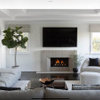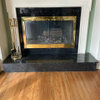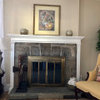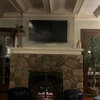Jotul Oslo 500 vs. Firelight 600 Wood Stoves
sweetcicely
15 years ago
More Discussions
Hi all,
I'm a refugee from the garden forums, but currently need HELP in choosing between the Jotul F500 (Oslo) and F600 Firelight.
We just lost the use of a large Morso free standing cast iron woodstove after almost 30 years of virtually trouble-free service. I've only recently discovered that they just aren't supposed to last that long! :)) (who knew??)
The stove provided all of our November through April heat (minus one month of below freezing nights). We are in northern California at 1500 feet (Sierra foothills), and in a 2600 sq ft home.
It seemed to me that because of the area we want to heat the Firelight Jotul F600 would be the best choice, but the dealer with whom we spoke recommended the Oslo F500 which he thought would be adequate. He also said he found the double door closure device on the Firelight 600 somewhat inconvenient to use.
Our Morso had solid double doors which served as part of the initial fire-up air system (made before everyone had to have glass doors). We really liked the system (and I never had to clean glass) and wonder about the dealer's hesitance about the Firelight's double doors.
Does anyone here have experience with either of these stoves ~ Jotul Oslo F500 or Firelight F600? I'd surely appreciate any pro/con information you can give me.
The live link below is to the F600, and here is the URL to the F500:
http://www.jotul.com/en-us/wwwjotulus/Main-menu/Products/Wood/Wood-stoves/Jotul-F-500-Oslo/
Thanks a bunch!
Sweetcicely
Here is a link that might be useful: Jotul F600 Firelight





Chris Newell
sweetcicelyOriginal Author
Related Professionals
North Ogden Fireplaces · Little Egg Harbor Twp Interior Designers & Decorators · Mount Laurel Interior Designers & Decorators · Arlington General Contractors · Deer Park General Contractors · DeKalb General Contractors · Erie General Contractors · Everett General Contractors · Longview General Contractors · Manalapan General Contractors · Middletown General Contractors · Phenix City General Contractors · Poquoson General Contractors · University Heights General Contractors · Valley Stream General Contractorssleeplesssound
secord2020_yahoo_com
sweetcicelyOriginal Author
coffeehaus
sweetcicelyOriginal Author
coffeehaus
sweetcicelyOriginal Author
bj20
HU-271929269